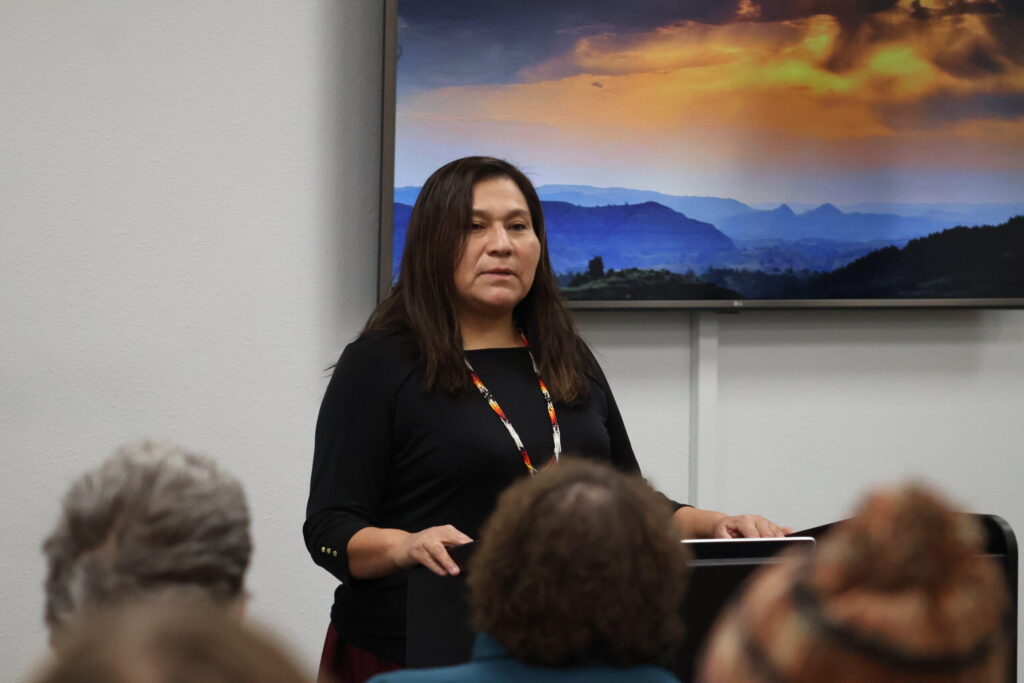
North Dakota Rep. Lisa Finley-DeVille, D-Mandaree, speaks during a presentation about the proposed Maah Daah Hey National Monument at the North Dakota Heritage Center and State Museum on Nov. 22, 2024. (Mary Steurer/North Dakota Monitor)
A group of North Dakota tribal citizens and conservation advocates are calling on President Joe Biden to make roughly 140,000 acres of undeveloped federal land in western North Dakota into a national monument.
The proposed Maah Daah Hey National Monument would preserve land recognized as sacred by members of the Mandan, Hidatsa and Arikara Nation and other Native cultures, advocates said during a Friday press conference at the North Dakota Heritage Center and State Museum.
“Maah Daah Hey” means “grandfather, long-lasting” in the Mandan language.
With its close proximity to President Theodore Roosevelt National Park, the area is popularly remembered for its ties to the former president and cowboy culture.
The country should honor Native historical and cultural ties to the land as well, said Michael Barthelemy, director of Native Studies at Nueta, Hidatsa, Sahnish College in New Town.
“What we’re proposing, as part of this national monument, is a reorientation around that narrative,” Barthelemy said. “When you look at the national parks and you look at the state parks, oftentimes there’s a singular perspective — as Indigenous people, we kind of play background characters.”
The monument would include 11 different plots of land along the Maah Daah Hey Trail between the north and south units of Theodore Roosevelt National Park.
Badlands Conservation Alliance Executive Director Shannon Straight likened the proposal to “stringing together the pearls of the Badlands.”
The tribal councils of the Mandan, Hidatsa and Arikara Nation, the Spirit Lake Nation and the Standing Rock Sioux Tribe have passed resolutions supporting the creation of the monument.
“It is important that the Indigenous history of the North Dakota Badlands is formally recognized,” state Rep. Lisa Finley-DeVille, D-Mandaree, said during the presentation. “If created, the Maah Daah Hey National Monument would also allow Indigenous people to reconnect to our ancestral lands.”
The land is managed by the United States Forest Service. Turning the 11 plots into a national monument would protect them from future development, according to the group’s proposal.
The land is surrounded by oil and gas development, maps included in the proposal show.

In addition to being an area of significant cultural heritage for Native tribes, it’s also home to sensitive ecosystems, unique geological features and fossil sites, the proposal indicates.
Dakota Resource Council Executive Director Scott Skokos said Friday the group has visited Washington, D.C., twice so far to speak with President Biden’s administration — including the U.S. Forest Service, Department of the Interior, United States Department of Agriculture — about the proposed monument.
“The reception has been pretty good,” Skokos said.
He said the group hopes to see action from Biden on the monument before he leaves office in January, but is also open to working with President-elect Donald Trump’s administration on the project.
“We believe this is a good idea, regardless of who’s president,” Skokos said.
Advocates said the designation would not impact recreational access to the land, and that cattle grazing would still be permitted.
In a statement to the North Dakota Monitor, U.S. Sen. Kevin Cramer, R-N.D., called the proposal “premature at best.” He said he was not convinced the proposal had sufficient local support from North Dakota residents and worried the project would “lock away land as conservation.”
“Any proposal should have extensive review as well as strong support from local communities and the stakeholders who actually use the land,” he said.
When asked for comment, the North Dakota governor’s office provided this statement from Gov. Doug Burgum, who Trump has chosen as the next Department of Interior secretary: “North Dakota is proof that we can protect our precious parks, cultural heritage and natural resources AND responsibly and sustainably develop our vast energy resources.”
To learn more about the proposal, visit protectmdh.com. The website also includes a petition.
Presidents can designate federal land as national monuments under the Antiquities Act of 1906. The first land to receive this status was Devils Tower in Wyoming, which Roosevelt proclaimed a national monument that same year.
Should Maah Daah Hey become a national monument, it’d be the first of its kind in North Dakota.
Like the SC Daily Gazette, North Dakota Monitor is part of States Newsroom, a nonprofit news network supported by grants and a coalition of donors as a 501c(3) public charity. North Dakota Monitor maintains editorial independence. Contact Editor Amy Dalrymple for questions: info@northdakotamonitor.com. Follow North Dakota Monitor on Facebook and X.

